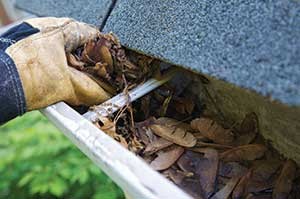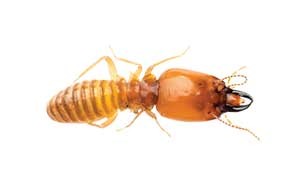
You can install and maintain rain gutters, proper downspouts and gutter protector material as another income stream. Photo: ©istock.com/maunger
Termites serve an important function in an ecosystem. They recycle cellulose, aerate soil, and serve as food for birds and predatory insects. In the Amazon, a family can expect a new house about every five years because termites eat the old structures. Much of the history of Brazilian architecture is in the belly of the termite.
Because we want to maintain our structures as long as possible, termite control is essential. Interestingly, termites and cows are two of the largest producers of methane gas, which contributes to global warming.
Generally, we think of green pest management in terms of general pest control, not termite control, because pesticide applications remain the foundation of termite management. However, there are nonchemical approaches pest management professionals (PMPs) can incorporate. Control should start with an inspection, an analysis of the problem, an evaluation and a holistic approach to an effective solution. Following are different facets of such programs. Select the methods most appropriate for the locations you’re trying to protect.
⦁ Use a moisture meter on every inspection and job. Moisture meters help pinpoint environmentally conducive conditions for harboring termites.
⦁ Use termite monitoring devices. Doing so helps early-warning detection.
⦁ Use foams to pinpoint where you apply pesticides. Foam helps reduce callbacks and extra pesticide use.
⦁ Do the job correctly the first time. This avoids returning and putting more pesticides into the soil.
⦁ Analyze the roots of your callbacks. Careful analysis will reveal your weaknesses and should result in fewer callbacks. Do you frequently miss stoops or trap areas in center bathrooms? Do you drill holes too far apart?
⦁ Be ready to evolve with the times. Look into heat and other nonchemical approaches. Always follow the label directions.

Give yourself an honest review to see how well you’re doing at becoming more environmentally conscientious (and profitable) in your subterranean termite work. Photo: ©istock.com/hunur/defun
Green termite techniques
There are many techniques from which to choose, including:
⦁ Baiting. Termite baits are green, however, they’re not exempt from creating an environmental hazard. One of the largest environmental claims in our industry occurred as a result of termite baiting. A technician drilled a hole to insert a termite bait and unknowingly hit an oil line. Only after the homeowner had to refill his in-ground oil tank in a few days did he realize something was wrong. By that time, oil leaked into the soil and spread to a nearby swamp.
⦁ Borates. Boric acid treatments make sense, especially where water tables are high. You don’t want to pump chemicals into soil because
it can leach into nearby canals, for example.
⦁ Cellulose removal. The more wood and cellulose debris surrounding a structure and within a crawlspace, the greater the chance of attracting termites. There’s also less chance termites will find the baits you install. Some companies have crews that specialize in removing such debris, including stumps.
⦁ Crawlspace ventilation. Proper ventilation helps minimize conditions conducive to attracting termites to moist crawlspace areas.
⦁ Gutter maintenance. You can install and maintain rain gutters, proper downspouts and gutter protector material as another income stream. The maintenance thereafter can coincide with termite inspections. Without gutters, rain will wash away soil treatments. With gutters, leaves will clog the drains and force water to cascade over the top of them, which will keep walls wet unless the customer hires you to maintain them.
⦁ Infrared cameras. These devices allow you to look into wall voids (you can even see the image of a house mouse) and detail temperature changes (moisture creates cooler areas). Infrared cameras are even built into smartphones.
⦁ Lights and glue boards. When you suspect termites are going to swarm from a basement or closet within several days, and chemical treatment isn’t a possibility for a few weeks, place a large glue board and a light source in the area. The termites will swarm to the light and get caught on the glue board. This will keep termites from flying into visible areas, and buy time until you can treat appropriately.
⦁ Physical barriers. A pretreat mechanical barrier, such as mesh or stone, only works if it’s installed properly and not penetrated by plumbers, electricians and other construction workers. Other barriers, such as sand and rubber mulch, need to be maintained at a certain depth to remain effective.
⦁ Reduced-risk termiticides. Some of the new liquid soil treatment products don’t require signal words on the label. Also, you don’t have to wear protective clothing to avoid pesticide exposure.
⦁ Vacuuming. There are times when customers are hysterical because of termite swarms. You might not be able to schedule a termite technician that same day, but you can send a general pest technician to vacuum the winged termites until a job can be scheduled. Use a vacuum with a high-efficiency particulate absorption (HEPA)-rated filter to avoid possible allergens that could be released back into the atmosphere. On rare occasions, the swarmer wings are left from last year’s treatment because, for example, someone opens a window, and the breeze scatters the wings. Again, vacuuming is the best option.
Last, but not least…
Give yourself an honest review to see how well you’re doing at becoming more environmentally conscientious (and profitable) in your subterranean termite work. The days of drilling, pumping — and repumping when it didn’t work the first time — are over. A job might require modified tips on rods and slab injection, foam, excavation, access to inaccessible areas, above-ground baits and/or major construction alterations. What a job doesn’t require is re-treating in the same manner as before.
7 termite account communication strategies
One of the key elements to keeping a happy termite control customer is being able to respect each other via friendly communication. Here are seven ideas to help you communicate better.
1. Appointment confirmation. Let your customer know a technician is on the way and who that person is, whether you use an email technician identification program or make a phone call from the office. It provides peace of mind.
2. Aerial maps. These maps are easily found online by typing an address into a mapping application and can help survey any obstacles you might encounter during treatment. Include these images on your inspection and treatment communications.
3. E-newsletters. Periodically send your customers helpful tips on how to keep a structure termite-free. Point out possible conducive conditions and ways to remove them.
4. Next-day satisfaction follow-up. The day after treatment, call or email (whichever method the customer opted for) your customer to ask if the work was satisfactory.
5. Preseason warm-up. Three weeks before termite swarming season, contact the jobs that you did last year (and ongoing trouble jobs from previous years) to ask whether everything is OK. Do this before the termite swarm because if they get swarmers three weeks later, they’ll contact you in a comfortable mindset, knowing you’ll take care of the problem.
6. Date stamping. An oldie, but a goodie: Use a hand stamp to date difficult-to-reach wooden floor joists in a crawlspace to prove you checked the area and keep track of when you were there.
7. Construction documentation. In new neighborhoods, take photos of the houses as they’re being built to document the progress. This way, when you approach the homeowners in a few years to sell a termite job, you and the customer will have a better idea of where and why the termites entered.
Contact Dr. Austin Frishman, a PMP Hall of Famer, at pmp@northcoastmedia.net.
Leave A Comment